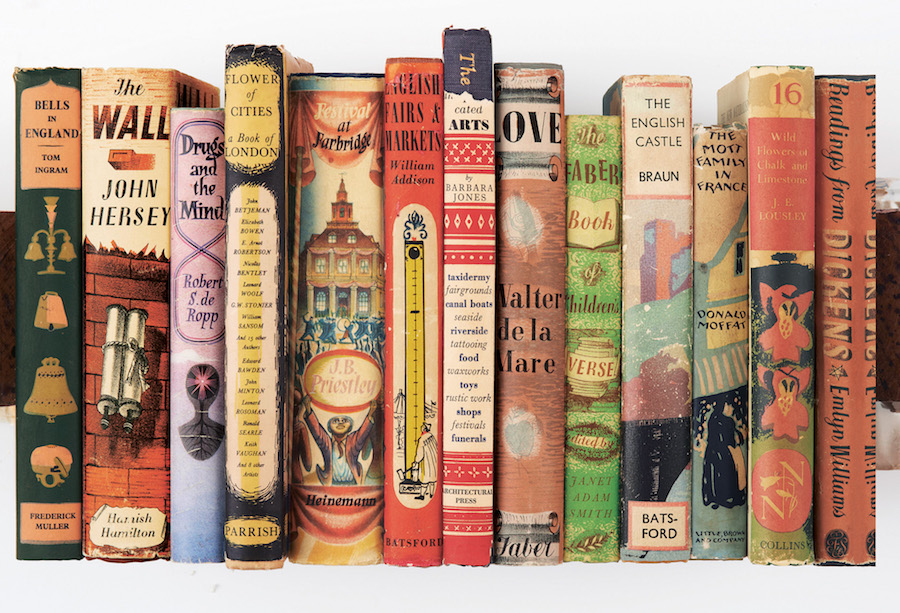Books are back in vogue
Here’s a look back at beautiful book jackets throughout the 20th century
As a new book delves into the history of the illustrated book jacket, we take a look at some of the most memorable cover designs.
They say not to judge a book by its cover, but dust jackets have had an important place in literary history.
Traditionally, book covers were very plain, but from the 1920s onwards there was a flourish of illustrated jackets, after the potential for them to help sell copies was spotted. Leading artists and illustrators, including John Piper, Edward Bawden and Ben Shahn, brought their visions to different books through the middle decades of the 20th century.
Now, in The Illustrated Dust Jacket: 1920-1970, professor of illustration, Martin Salisbury delves into the history of book covers through the decades (some very famous and others much forgotten), while some of the artists reveal how the book jacket evolved from the plain wrapping of the 19th century to eye-catching pieces of art and promotional tools.
The designs tells us more than just what’s in store in the book however; they also reflect the changing styles of the different periods, including the art deco years and post-war Neo-Romanticism.
Here’s a look at some of the highlights…
1920s
Metropolis

Metropolis by Thea von Harbou, Readers Library, 1927 (Collection of Mark Terry/Facsimile Dust Jackets L.L.C. www.dustjackets.com/PA)
The 1925 futuristic novel Metropolis, by German author Thea von Harbou, created a technologically advanced city in 2026, sustained by an underground world of labourers. In a story reminiscent of HG Wells’ earlier romances, the son of one of the city’s founders falls in love with a girl from the underground society. The art deco-style dust jacket, by Aubrey Hammond, was one of the standouts in the 20th century. According to The Illustrated Dust Jacket, ‘Hammond’s design juxtaposes delicate colour harmony with nightmarish vision’. His work was also a familiar sight in advertising in the Twenties and Thirties, but he’s probably most remembered for Metropolis – the image became as iconic as the popular 1927 film.
1930s
Moby Dick

Moby Dick, Herman Melville, Random House 1930 (Kent Rothwell/From the collection of Mark Terry / Fascicle Dust Jackets LLC, www.dustjackets.com. The estate of Rockwell Kent. Courtesty of the Plattsburgh State Art Museum, Plattsburgh College Foundation, Rockwell Kent Gallery and Collection, Bequest of Sally Kent Gordan, Plattsburgh, New York/PA)
Herman Melville’s 1851 novel needs no introduction. The coming-of-age tale of narrator Ishamael, and a voyage on a whaling boat searching for a legendary white whale, Moby Dick has become a staple in every high-school English class. There was a resurgence of interest in the novel 80 years after publication, and the 1930 edition, illustrated by New York artist Rockwell Kent, is said to have been a factor. Interestingly, Kent was so prominent at the time that his name features on the jacket, while Melville’s doesn’t. Kent drew on the experience of his travels, including Alaska, Greenland and Puerto Rico, to illustrate the book. After this, Moby Dick secured its place as one of the great American novels of all time.
1940s
A Street Car Named Desire

A Streetcar Named Desire Tennessee Wiliams, New Directions,1947 (Collection of Mary Terry / Facsimile Dust Jackets L.L.C. www.dustjackets.com. Reproduced by permission of the Alvin Lustig Archive/PA)
Alvin Lustig brought something completely different to the book jacket world, his pictorial designs using geometric shapes and patterns. His Modernist approach was considered very innovative in the Forties and early-Fifties. Lustig did the first edition book jacket for A Street Car Named Desire, by Tennessee Williams, in 1947, about a young woman who travels to New Orleans after losing her home and husband, and her subsequent breakdown. The play went on to receive a Pulitzer Prize for Drama the following year and is generally regarded as one of the best of the 20th century. Lustig lost his eyesight at the age of 39, due to complications linked with diabetes, but continued to design with the help of his wife, before his death the following year.
1950s
Tom’s Midnight Garden

Tom’s Midnight Garden, by Philippa Pearce, J. B. Lippincott 1958 (The Estate of Susan Einzig. Courtesy Hetty Einzig/PA)
The children’s classic, Tom’s Midnight Garden by Philippa Pearce, explores the nature of time and reality, centred around a boy, Tom, living under quarantine with his aunt and uncle in a converted building that was once a country house in the 1880s. Tom goes back in time to the old garden, where he meets a girl. The book jacket and illustration of the first edition in 1958 is British artist Susan Einzig’s most famous piece of work from at the end of the Neo-Romantic period. Despite her success, Einzig never felt confident about her talents. The Illustrated Dust Jacket describes her as saying: “Every drawing I have done is like a first drawing in which I have to discover how to do it – it’s so difficult that I sometimes wonder how I’ve stuck to it.”
1960s
The Borrowers Aloft

The Borrowers Aloft Harcourt, Brace and World, NY, 1961 (By permission of Joe Krush/PA)
Who could forget The Borrowers, the miniscule Clock family who borrow from the ‘big people’, with teenager Arrietty’s antics always getting the family in trouble? It was husband and wife team Beth and Joe Krush who brought Mary Norton’s characters to life in the wildly successful five-part children’s book series. The Borrowers was published in 1953, followed by the likes of The Borrowers Afield and The Borrowers Aloft, which hit bookshelves in 1961. By now, the illustrators were highly renowned for their composition, use of bright colour, and quintessentially English setting in their line drawings.

The Illustrated Dust Jacket (Thames & Hudon/PA)
The Illustrated Dust Jacket: 1920 -1970 by Martin Salisbury is published by Thames & Hudson, priced £24,95. Available now.
The Press Association
Latest posts by The Press Association (see all)
- 3 recipes to make from the new Hairy Bikers cookbook - April 26, 2024
- World Penguin Day: Test your knowledge with our penguin-themed quiz - April 23, 2024
- Kate’s new photo of Louis released to celebrate prince’s sixth birthday - April 23, 2024
- Alan Titchmarsh: Slugs are never going to be my friends - April 23, 2024
- Prince Louis celebrates sixth birthday - April 23, 2024






















